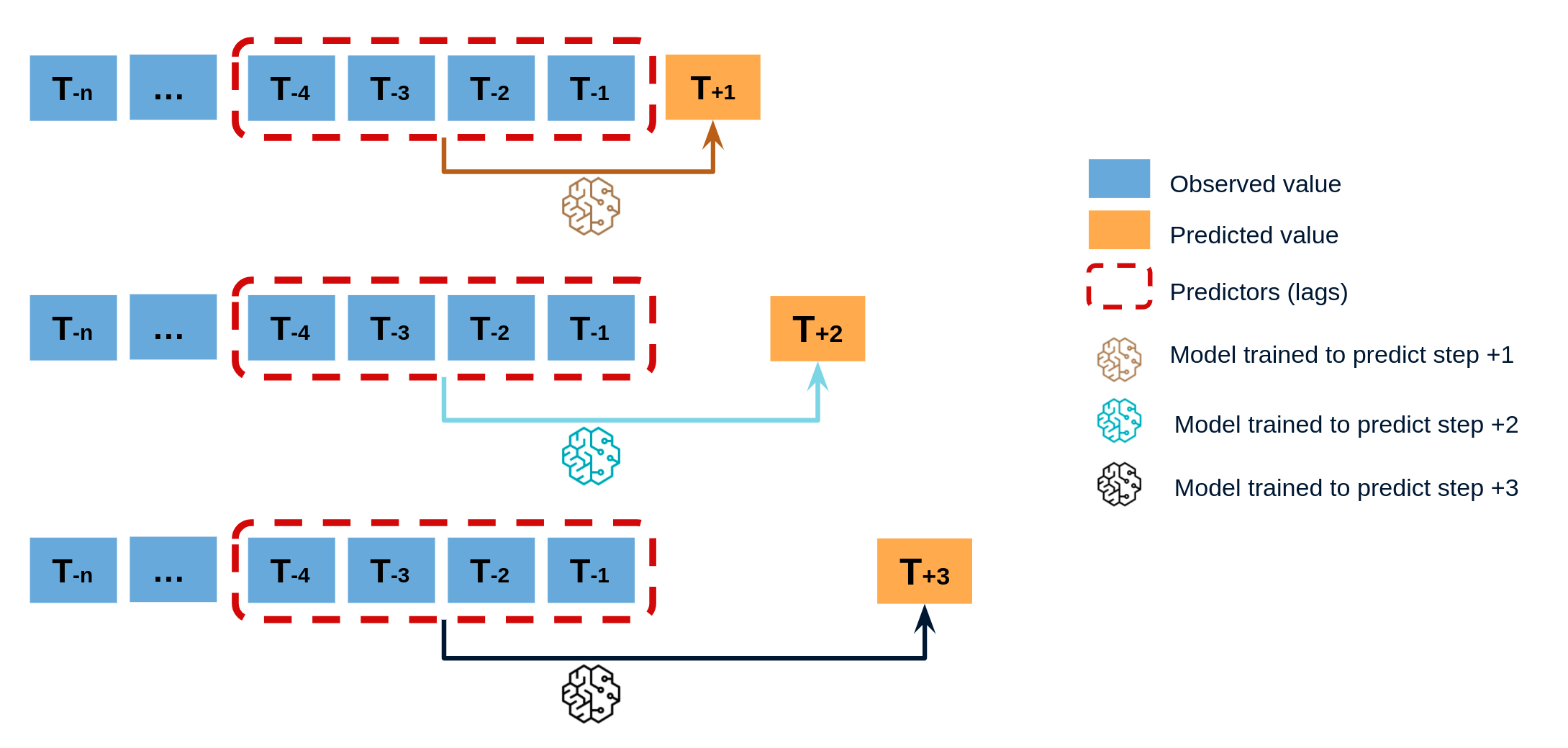Direct multi-step forecaster¶
ForecasterAutoreg and ForecasterAutoregCustom models follow a recursive prediction strategy in which each new prediction builds on the previous one. An alternative is to train a model for each step that has to be predicted. This strategy, commonly known as direct multistep forecasting, is computationally more expensive than the recursive since it requires training several models. However, in some scenarios, it achieves better results. This type of model can be obtained with the ForecasterAutoregDirect class and can also include one or multiple exogenous variables.

To train a ForecasterAutoregDirect a different training matrix is created for each model.
Libraries¶
# Libraries
# ==============================================================================
import numpy as np
import pandas as pd
import matplotlib.pyplot as plt
from skforecast.ForecasterAutoregDirect import ForecasterAutoregDirect
from sklearn.linear_model import Ridge
from sklearn.metrics import mean_squared_error
Data¶
# Download data
# ==============================================================================
url = ('https://raw.githubusercontent.com/JoaquinAmatRodrigo/skforecast/master/data/h2o.csv')
data = pd.read_csv(url, sep=',', header=0, names=['y', 'datetime'])
# Data preprocessing
# ==============================================================================
data['datetime'] = pd.to_datetime(data['datetime'], format='%Y/%m/%d')
data = data.set_index('datetime')
data = data.asfreq('MS')
data = data['y']
data = data.sort_index()
# Split train-test
# ==============================================================================
steps = 36
data_train = data[:-steps]
data_test = data[-steps:]
# Plot
# ==============================================================================
fig, ax=plt.subplots(figsize=(9, 4))
data_train.plot(ax=ax, label='train')
data_test.plot(ax=ax, label='test')
ax.legend();
Train forecaster¶
# Create and fit forecaster
# ==============================================================================
forecaster = ForecasterAutoregDirect(
regressor = Ridge(),
steps = 36,
lags = 15
)
forecaster.fit(y=data_train)
forecaster
=======================
ForecasterAutoregDirect
=======================
Regressor: Ridge()
Lags: [ 1 2 3 4 5 6 7 8 9 10 11 12 13 14 15]
Transformer for y: None
Transformer for exog: None
Included weights function: False
Window size: 15
Maximum steps predicted: 36
Weight function included: False
Exogenous included: False
Type of exogenous variable: None
Exogenous variables names: None
Training range: [Timestamp('1991-07-01 00:00:00'), Timestamp('2005-06-01 00:00:00')]
Training index type: DatetimeIndex
Training index frequency: MS
Regressor parameters: {'alpha': 1.0, 'copy_X': True, 'fit_intercept': True, 'max_iter': None, 'normalize': 'deprecated', 'positive': False, 'random_state': None, 'solver': 'auto', 'tol': 0.001}
Creation date: 2022-11-30 16:43:22
Last fit date: 2022-11-30 16:43:22
Skforecast version: 0.6.0
Python version: 3.9.13
Prediction¶
When predicting, the value of steps must be less than or equal to the value of steps defined when initializing the forecaster. Starts at 1.
If
intonly steps within the range of 1 to int are predicted.If
listof ints. Only the steps contained in the list are predicted.If
Noneas many steps are predicted as were defined at initialization.
# Predict
# ==============================================================================
predictions = forecaster.predict()
print('As many steps are predicted as have been defined in the initialization.')
display(predictions.head(3))
predictions = forecaster.predict(steps=[1, 5])
print('')
print('Only the steps contained in the list are predicted.')
display(predictions)
As many steps are predicted as have been defined in the initialization.
2005-07-01 0.952051 2005-08-01 1.004145 2005-09-01 1.114590 Name: pred, dtype: float64
Only the steps contained in the list are predicted.
2005-07-01 0.952051 2005-11-01 1.179922 Name: pred, dtype: float64
# Plot predictions
# ==============================================================================
fig, ax=plt.subplots(figsize=(9, 4))
data_train.plot(ax=ax, label='train')
data_test.plot(ax=ax, label='test')
predictions.plot(ax=ax, label='predictions')
ax.legend();
# Prediction error
# ==============================================================================
predictions = forecaster.predict(steps=36)
error_mse = mean_squared_error(
y_true = data_test,
y_pred = predictions
)
print(f"Test error (mse): {error_mse}")
Test error (mse): 0.008419597278831967
Feature importance¶
Since ForecasterAutoregDirect fits one model per step, it is necessary to specify from which model retrieves its feature importance.
forecaster.get_feature_importance(step=1)
| feature | importance | |
|---|---|---|
| 0 | lag_1 | 0.139299 |
| 1 | lag_2 | 0.051089 |
| 2 | lag_3 | 0.044192 |
| 3 | lag_4 | -0.019868 |
| 4 | lag_5 | -0.017935 |
| 5 | lag_6 | -0.013233 |
| 6 | lag_7 | -0.021063 |
| 7 | lag_8 | -0.012591 |
| 8 | lag_9 | 0.011918 |
| 9 | lag_10 | 0.020511 |
| 10 | lag_11 | 0.154030 |
| 11 | lag_12 | 0.551652 |
| 12 | lag_13 | 0.057513 |
| 13 | lag_14 | -0.071071 |
| 14 | lag_15 | -0.035237 |
Extract training matrix¶
Two steps are needed. One to create the whole training matrix and a second one to subset the data needed for each model (step).
X, y = forecaster.create_train_X_y(data_train)
# X and y to train model for step 1
X_1, y_1 = forecaster.filter_train_X_y_for_step(
step = 1,
X_train = X,
y_train = y,
)
X_1.head(4)
| lag_1 | lag_2 | lag_3 | lag_4 | lag_5 | lag_6 | lag_7 | lag_8 | lag_9 | lag_10 | lag_11 | lag_12 | lag_13 | lag_14 | lag_15 | |
|---|---|---|---|---|---|---|---|---|---|---|---|---|---|---|---|
| datetime | |||||||||||||||
| 1995-09-01 | 0.534761 | 0.475463 | 0.483389 | 0.410534 | 0.361801 | 0.379808 | 0.351348 | 0.336220 | 0.660119 | 0.602652 | 0.502369 | 0.492543 | 0.432159 | 0.400906 | 0.429795 |
| 1995-10-01 | 0.568606 | 0.534761 | 0.475463 | 0.483389 | 0.410534 | 0.361801 | 0.379808 | 0.351348 | 0.336220 | 0.660119 | 0.602652 | 0.502369 | 0.492543 | 0.432159 | 0.400906 |
| 1995-11-01 | 0.595223 | 0.568606 | 0.534761 | 0.475463 | 0.483389 | 0.410534 | 0.361801 | 0.379808 | 0.351348 | 0.336220 | 0.660119 | 0.602652 | 0.502369 | 0.492543 | 0.432159 |
| 1995-12-01 | 0.771258 | 0.595223 | 0.568606 | 0.534761 | 0.475463 | 0.483389 | 0.410534 | 0.361801 | 0.379808 | 0.351348 | 0.336220 | 0.660119 | 0.602652 | 0.502369 | 0.492543 |
y_1.head(4)
datetime 1995-09-01 0.568606 1995-10-01 0.595223 1995-11-01 0.771258 1995-12-01 0.751503 Freq: MS, Name: y_step_1, dtype: float64
%%html
<style>
.jupyter-wrapper .jp-CodeCell .jp-Cell-inputWrapper .jp-InputPrompt {display: none;}
</style>